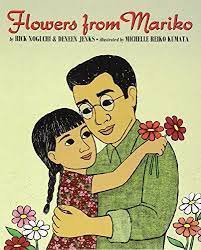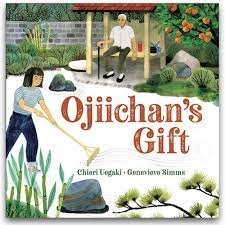The Essential Reading List for 2022
By Corinne Kennedy
Dokusho no Aki - 読書の秋, or “Autumn, The Season for Reading” is a common saying in Japan, and it’s a popular time of the year for all kinds of themed reading lists to be published. As the days grow colder and the nights get longer here in Seattle, books are a welcome companion. For your fall enrichment, Corinne Kennedy has compiled an eclectic list of fourteen titles, including ten books for children and teens (haiku poetry, picture books, a novel, and a biography) and four non-fiction works for adults.
Acer palmatum ‘Koto-no-ito’ in the Seattle Japanese Garden. (photo: Aleks Monk)
This Essential Reading List for 2022 is a departure from my previous November reading list articles, which have seldom included even a single book for children or teens. But earlier this year I was inspired by the amazing children’s books I was re-shelving during my weekly volunteer shift at the Elisabeth C. Miller Library, so this year’s article includes ten books for children and teens—haiku poetry, picture books, a novel, and a biography. (Nine are available for checkout at the Miller Library.) Recurring themes are Japanese gardens and poetry, the world of nature and the seasons, and discrimination against Japanese immigrants and their children (in the mid-19th century as well as during World War II), themes that are echoed in the four non-fiction books for adults (two available at the Miller Library) that complete this year’s list.
BOOKS FOR CHILDREN AND TEENS:
The beautifully colored autumn leaves of Acer palmatum ‘Samidare’ in the Seattle Japanese Garden. (photo: Aleks Monk, October 2013).
· Chirri & Chirra In the Tall Grass. Written and illustrated by Kaya Doi. English translation by Yuki Kaneko (2017). Written by a Japanese writer/artist who lives in Chiba Prefecture, east of Tokyo, this book was selected by Kirkus Reviews as “A Best Picture Book of 2017 To Connect Kids with Nature.” Their review called it “utterly charming” and a “serene, sylvan outing.” As described by publisher Enchanted Lion Books, twins “Chirri and Chirra go on an imaginative adventure where they discover the small overlooked mysteries of the natural world.” It’s a sweet, magical and joyful treasure for ages 2-8—and even for adults!
· Flowers from Mariko, by Rick Noguchi & Deneen Jenks, illustrated by Michelle Reiko Kumata (2001).
With beautiful illustrations by Seattle’s own Michelle Kumata, whose art has been displayed in the Elisabeth C. Miller Library and at the Seattle Japanese Garden, this picture book begins as Mariko and her family are finally being released from the World War II internment camp where they’ve been incarcerated for nearly three years. Her father’s truck was stolen and he’s unable to restart his gardening business; nonetheless, Mariko plants seeds of flowers that he grew in the camp. “Based on the injustice endured by Japanese Americans during and after World War II, Flowers from Mariko shows us all the power of hope, love, and a young girl’s determination to help her family rebuild their lives.” (from the book jacket). Grades 1-4.
· Heart of a Samurai: Based on the True Story of Manjiro Nakahama, by Margi Preus (2010). This novel is based on the true story of a fourteen-year-old Japanese boy whose boat was destroyed in 1841 in a storm. He and four other fishermen are stranded for months on an uninhabited island before being rescued by an American whaling ship. A coming-of-age story illustrated with Manjiro’s own drawings, it chronicles his experiences on the ship and in New Bedford, Massachusetts, as the adopted son of the ship’s captain—as well as his eventual return to his home in Japan. Well-written, exciting, adventurous, and timely in its treatment of anti-Japanese bigotry and discrimination. Ages 10-16.
· In a Spring Garden, edited by Richard Lewis, illustrated by Ezra Jack Keats (1965). English translations of classic haiku poems by Issa, Bashō, Buson, and other well-known Japanese poets, paired with evocative illustrations by Ezra Keats, a Caldecott Medal winner. Ages 4-8.
· Nature Art with Chiura Obata, by Michael Elsohn Ross, illustrated by Wendy Smith (2000). The inspiring story of Japanese American artist Chiura Obata, who was adopted by his older brother, an artist, at the age of five. He showed a talent for painting—and studied under several master teachers—from a very young age. At seventeen he left Japan for California, to explore the natural wonders of the U.S. Over a decades-long career, he became a West Coast artist of major importance and a beloved teacher, inspiring hundreds of students—despite the realities of anti-Japanese bigotry and his confinement in a World War II internment camp. This slim but comprehensive biography includes reproductions of his paintings and drawings and sidebars that describe practices for young readers who want to create their own nature art. Grades 4-7.
· Ojiichan’s Gift, by Chieri Uegaki, illustrated by Genevieve Simms (2019).
Inspired by the author’s late father, a traditional Japanese landscaper/gardener, this picture book is about a young girl who visits her Ojiichan (grandfather) in Japan each summer. Together they take care of the garden he built for her—until one year his health has changed and he is forced to move. The author dedicates it “in memory of Aiko and Alexander’s Ojiichan, and for those who make gardens, wherever and however they can.” Ages 3-7.
· One Leaf Rides the Wind: Counting in a Japanese Garden, by Celeste Davidson Mannis, illustrated by Susan Kathleen Hartung (2002). Not simply a counting or picture book, this slim volume was inspired by the author’s daughters, who were fascinated by a Japanese garden they had visited on a family vacation. Eleven haiku poems count leaves, stone temple dogs, bonsai pots and more—and reveal the beauty and tranquility of Japanese gardens. The poems are paired with striking illustrations and statements that illuminate each subject. For example, the first haiku (“One leaf rides the wind./Quick as I am, it’s quicker!/Just beyond my grasp./”) is paired with this sentence: “Within the burnished depths of an autumn leaf is the story of seasons past and seasons yet to come.” Ages 4-8.
· A Place Where Sunflowers Grow, by Amy Lee-Tai, illustrated by Felicia Hoshino (2006). Inspired by her grandmother and mother’s World War II experiences in the Topaz internment camp, this picture book is the story of Mari, who attends an art class in camp, but can’t think of anything to draw. She wonders if sunflowers will even grow and bloom in the camp’s harsh desert environment. But with the help of a supportive art teacher, her parents and a new friend, Mari is finally able to feel the beginnings of hope. Hoshino based some of her superb mixed-media illustrations on art created by the author’s grandmother, Hisako Hibi, a prominent Japanese American painter. Ages 6-up.
· The Tea Party in the Woods, written and illustrated by Akiko Miyakoshi. English edition edited by Katie Scott and Yvette Ghione (2015).
This picture book for children preschool to grade two is a charming fairy tale with lovely, evocative illustrations. Kikko sets out through snowy woods to bring a pie to her grandmother and discovers a wondrous house of friendly animals, who invite her to their tea party. Afterwards, they joyfully accompany her through the woods to her grandma’s house.
· The Year Comes Round: Haiku through the Seasons, by Sid Farrar, illustrated by Ilse Plume (2012). Thirteen haiku nature poems take readers on a journey through the seasons. Includes beautiful watercolor illustrations by a Caldecott Honor winner. Ages 5-up.
BOOKS FOR ADULTS:
The elegant white flowers of Camellia oleifera, blooming in autumn. (photo: Corinne Kennedy)
· of arcs & circles: insights from japan on gardens, nature, and art, by Marc Peter Keane (2022). “Landscape artist Marc Peter Keane’s most recent collection of essays, ‘Of Arcs and Circles,’ pulses with wisdom. His meandering insights inspire frequent reading breaks for further contemplation…. As a garden expert and writer who has lived in Kyoto for more than 20 years, Keane’s essays, like his design work, are deeply influenced by Japanese aesthetics. His words loop easily from metaphysical questioning to practical observations, with clear nods to the winding structure of the Japanese zuihitsu personal essay form…. Even when considering concepts such as wabi-sabi (imperfection) or emptiness, Keane’s essays are grounded in his own experiences. His observations stem from his young adulthood in the United States, his many years in Japan as a specialist in Japanese garden design, and his home in Ithaca, New York. This blend of places expands his ideas with a touch of relatability, even for readers unfamiliar with Japanese culture or the country.” (from a review by Kris Kosaka in The Japan Times, February 13, 2022.)
· Children of Manzanar, a project of the Manzanar History Association, edited by Heather C. Lindquist (2012). A compilation of photographs and remembrances, capturing the experiences of some of the nearly four thousand children and young adults held in Manzanar, California, one of the camps where Japanese and Japanese Americans were incarcerated during World War II. Includes quotations from later oral history interviews with those interned as children—and many photographs, by internee Toyo Miyatake as well as by professional photographers hired by the WRA (War Relocation Authority), including Dorothea Lange and Ansel Adams.
· Chiura Obata: An American Modern. Catalogue from an exhibition of Obata’s art at the Art, Design & Architecture Museum, University of California, Santa Barbara. By ShiPu Wang, with contributions by Masuji Fujii, Asako Katsura and Greg Robinson (2018).
“Chiura Obata (1885-1975) was one of the most significant Japanese American artists working on the West Coast in the past century. Born in Okayama, Japan, Obata emigrated to the United States in 1903 and embarked on a seven-decade career…. [He] emerged as a leading figure in the Northern California artistic communities, serving not only as an influential art professor at UC Berkeley for nearly twenty years but also as a founding director of art schools in the internment camps…. His faith in the power of art, his devotion to preserving the myriad grandeur of what he called ‘Great Nature,’ and his compelling personal story as an immigrant and an American are all as relevant to our contemporary moment as ever.” (from the book jacket). Includes over 100 images of Obata’s art, many not previously published, a selection of his writings, excerpts from a 1965 interview, and scholarly essays by the contributors.
· Rock, water, plant: garden masters’ record: Japanese writers on the Japanese Garden in Washington Park Arboretum, Seattle, 1959-2010 / collected and translated by Shizue Prochaska and Julie E. Coryell (2021). The result of many years of collaboration between Arboretum Unit 86 members Prochaska and Coryell, this collection includes English translations of the Seattle Japanese Garden’s foundational documents and a retrospective published fifty years later—all originally written in Japanese. The Garden’s design was a gift from the Tokyo Metropolitan Park Department Green Spaces Division, and these important documents detail the creators’ work from planning through installation, “enrich[ing] our understanding of the vision, talent, engineering, [and] care to make this garden gift.” The Elisabeth C. Miller Library has two copies, one available for checkout, and a pdf copy accessible from the library’s online catalogue.
Corinne Kennedy is a Garden Guide, a frequent contributor to the Seattle Japanese Garden blog, and retired garden designer.






